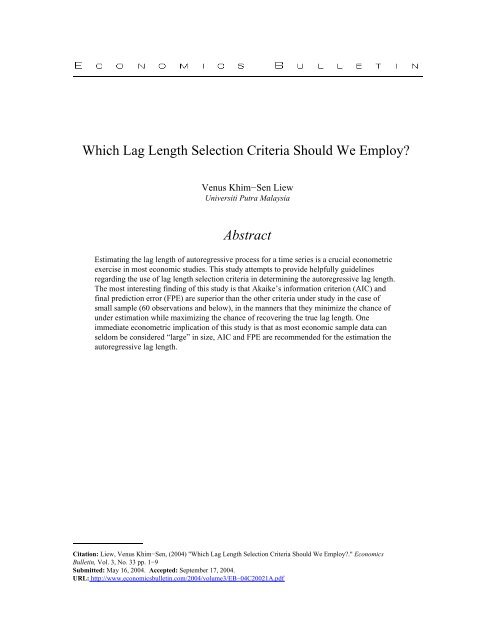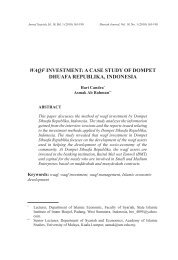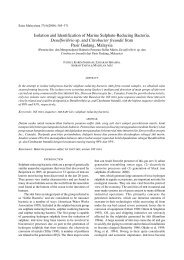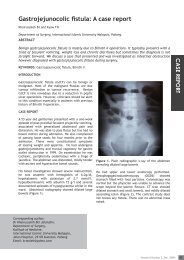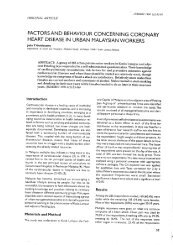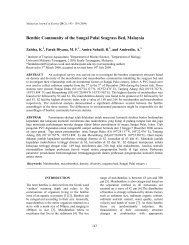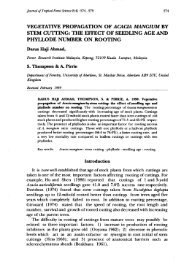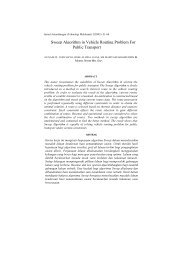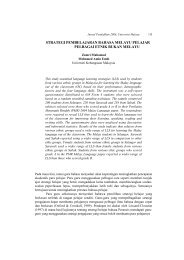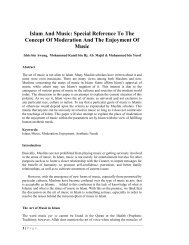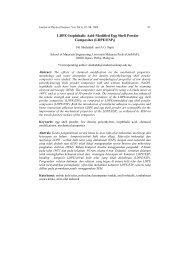Which Lag Length Selection Criteria Should We Employ? Abstract
Which Lag Length Selection Criteria Should We Employ? Abstract
Which Lag Length Selection Criteria Should We Employ? Abstract
Create successful ePaper yourself
Turn your PDF publications into a flip-book with our unique Google optimized e-Paper software.
<strong>Which</strong> <strong>Lag</strong> <strong>Length</strong> <strong>Selection</strong> <strong>Criteria</strong> <strong>Should</strong> <strong>We</strong> <strong>Employ</strong>?<br />
Venus Khim−Sen Liew<br />
Universiti Putra Malaysia<br />
<strong>Abstract</strong><br />
Estimating the lag length of autoregressive process for a time series is a crucial econometric<br />
exercise in most economic studies. This study attempts to provide helpfully guidelines<br />
regarding the use of lag length selection criteria in determining the autoregressive lag length.<br />
The most interesting finding of this study is that Akaike’s information criterion (AIC) and<br />
final prediction error (FPE) are superior than the other criteria under study in the case of<br />
small sample (60 observations and below), in the manners that they minimize the chance of<br />
under estimation while maximizing the chance of recovering the true lag length. One<br />
immediate econometric implication of this study is that as most economic sample data can<br />
seldom be considered “large” in size, AIC and FPE are recommended for the estimation the<br />
autoregressive lag length.<br />
Citation: Liew, Venus Khim−Sen, (2004) "<strong>Which</strong> <strong>Lag</strong> <strong>Length</strong> <strong>Selection</strong> <strong>Criteria</strong> <strong>Should</strong> <strong>We</strong> <strong>Employ</strong>?." Economics<br />
Bulletin, Vol. 3, No. 33 pp. 1−9<br />
Submitted: May 16, 2004. Accepted: September 17, 2004.<br />
URL: http://www.economicsbulletin.com/2004/volume3/EB−04C20021A.pdf
1. Introduction<br />
It is well known that most economic data are time series in nature and that a popular kind<br />
of time series model known as autoregressive (AR) model has been directly or indirectly<br />
applied in most economic researches. Note that the foremost exercise in the application of<br />
AR model is none other than the determination of autoregressive lag length. In this<br />
respect, many lag length selection criteria have been employed in economic study to<br />
determine the Autoregressive (AR) lag length of time series variables. Briefly, an AR<br />
process of lag length p refers to a time series in which its current value is dependent on its<br />
first p lagged values and is normally denoted by AR (p). Note that the AR lag length p is<br />
always unknown and therefore has to be estimated via various lag length selection criteria<br />
such as the Aikaike’s information criterion (AIC) (Akaike 1973), Schwarz information<br />
criterion (SIC) (Schwarz 1978) Hannan-Quinn criterion (HQC) (Hannan and Quinn<br />
1979), final prediction error (FPE) (Akaike 1969), and Bayesian information criterion<br />
(BIC) (Akaike 1979); see Liew (2000) for an overview of these criteria. These criteria<br />
especially the AIC have been popularly adopted in economic studies, see for examples<br />
the works of Sarantis (1999, 2001) and Baum et al. (2001), Baharumshah et al. (2002),<br />
Ng (2002) and Tang (2003) who employed the AIC, Sarno and Taylor (1998) who<br />
employed the AIC and SIC, Ahmed (2000) who used the AIC and BIC, Yamada (2000)<br />
who used AIC and HQC, Tan and Baharumshah (1999) and Ibrahim (2001) who<br />
deployed the FPE, Dropsy (1996), Azali et al. (2001) and Xu (2003) who utilized the SIC<br />
in their empirical research. However, no special study has been allocated to contrast the<br />
performances of these lag length selection criteria, although few empirical studies (Taylor<br />
and Peel 2000, Baum et al. 2001, Guerra 2001) do notify the inconsistency of these<br />
criterion and their tendency to under estimate the autoregressive lag length 1 . This<br />
simulation study is specially conducted to compare the empirical performances of various<br />
lag length selected criteria, with the principle objective of discovering the best choice of<br />
lag length criteria, an issue which has substantial econometric impact on most empirical<br />
economic studies.<br />
The major findings in the current simulation study are previewed as follows. First,<br />
these criteria managed to pick up the correct lag length at least half of the time in small<br />
sample. Second, this performance increases substantially as sample size grows. Third,<br />
with relatively large sample (120 or more observations), HQC is found to outdo the rest<br />
in correctly identifying the true lag length. In contrast, AIC and FPE should be a better<br />
choice for smaller sample. Fourth, AIC and FPE are found to produce the least<br />
probability of under estimation among all criteria under study. Finally, the problem of<br />
over estimation, however, is negligible in all cases. The findings in this simulation study,<br />
besides providing formal groundwork supportive of the popular choice of AIC in<br />
previous empirical researches, may as well serve as useful guiding principles for future<br />
economic researches in the determination of autoregressive lag length.<br />
The rest of this paper is organized as follows. Section 2 briefly describes the AR<br />
process, the lag length selection criteria and simulation procedure. Section 3 presents and<br />
discusses the results of this simulation study. Section 4 offers a summary of this study.<br />
1 A related work by Liew (2000) studies the performance of an individual criteria, namely the Aikaike’s<br />
biased corrected information criterion, AICC. The current study is more comprehensive than Liew (2000)<br />
in the sense that more criteria are involved for the purpose of comparative study.<br />
1
2.1 Autoregressive process<br />
2. Methodology of Study<br />
Mathematically, an AR(p) process of a series y t may be represented by<br />
yt = a1<br />
yt<br />
− 1 + a2<br />
yt<br />
−2<br />
+ ... + ap<br />
yt<br />
− p + εt<br />
(1)<br />
where p a a a ,..., , 1 2 are autoregressive parameters andε t are normally distributed random<br />
2<br />
error terms with a zero mean and a finite variance σ .<br />
The estimation of AR (p) process involves 2 stages: First, identify the AR lag<br />
length p based on certain rules such as lag length selection criteria. Second, estimate the<br />
numerical values for intercept and parameters using regression analysis. This study is<br />
confined to the study of the performances of various commonly used lag length selection<br />
criteria in identifying the true lag length p. In particular, this study generates AR<br />
processes with p arbitrary fixed at a value of 4 and uses these criteria to determine the lag<br />
length of each generated series as if the lag length is unknown. The autoregressive<br />
parameters are independently generated from uniform distribution with values ranging<br />
from -1 to 1 exclusively. Measures are taken to ensure that the sum of these simulated<br />
autoregressive parameters is less than unity in magnitude (| a 1 + a2<br />
+ a3<br />
+ a4<br />
|< 1) so as to<br />
avoid non-stationary AR process. The error term is generated from standard normal<br />
distribution. <strong>We</strong> simulate data sets for various usable sample sizes, S: 30, 60, 120, 240,<br />
480 and 960. For each combination of processes and sample sizes, we simulated 1000<br />
independent series for the purpose of lag length estimation. In every case, the initial<br />
value, y 0 is arbitrary set to zero. In an effort to minimize the initial effect, we simulate<br />
3S observations and discard the first 2S observations, leaving the last S observations for<br />
lag length estimation. The estimated lag length pˆ is allowed to be determined from any<br />
integer ranging from 1 to 20 inclusively. In this respect, we compute the values for all 20<br />
lag lengths for each specific criterion and pˆ is taken from the one that minimizes that<br />
criterion. Note that each criterion independently selects one pˆ for the same simulated<br />
series.<br />
2.2 <strong>Lag</strong> length selection criteria<br />
The lag length selection criteria to be evaluated include 2 :<br />
(a) Akaike information criterion,<br />
2<br />
AICp= – 2T [ln( σ ˆ p )] + 2p ; (2)<br />
(b) Schwarz information criterion, SICp = ln( σ )+ [p ln(T)]/T ; (3)<br />
2<br />
(c) Hannan-Quinn criterion, HQCp = ln( σ ˆ p )+2T<br />
−1<br />
p ln[ln(T)]; (4)<br />
σ<br />
−1<br />
( T − p)<br />
( T + p)<br />
and (5)<br />
(d) the final prediction error, FPEp= 2 ˆ p<br />
2<br />
Among other criteria not taken up in this study include: First, the Schwert (1987, 1989) criteria, which are<br />
defined as [(4S/100) 0.25 ] and [(12S/100) 0.25 ] respectively, with S denoting the sample size and [A] stands for<br />
the integer part of the real number A, see for instance Habibullah (2001) and Habibullah and Baharumshah<br />
(2001) for their applications. Second, the Akaike’s corrected information criterion, AICCp= –2T [ln( σ )]<br />
+ 2Tp / (T – p), see Liew (2000) for a simulation study on its performance as well as its application. Last<br />
but not least, the partial autocorrelation function as applied in among others, Taylor and Peel (2000),<br />
Guerrra (2001) and Liew et al. (2003).<br />
2<br />
2<br />
ˆ p<br />
2<br />
ˆ p
(e) Bayesian information criterion,<br />
−1<br />
2<br />
−1<br />
2 2<br />
BICp=(T–p) ln[ ( T − p)<br />
Tσ<br />
p ]+T[1+ln( 2 π )]+ p ln[ p ∑ y − Tσ<br />
ˆ ) ], (6)<br />
T<br />
2 ˆ<br />
−1<br />
2<br />
where σ ˆ p = ( T − p −1)<br />
∑ ε t , ε t is the model’s residuals and T is the sample size.<br />
t=<br />
p<br />
Note that the cap sign (^) indicates an estimated value. Liew (2000) provides an<br />
overview on these criteria, whereas details are given in, for instance, Brockwell and<br />
Davis (1996) and the references therein.<br />
The main task of this study is to compute the probability of each of these criteria<br />
in correctly estimated the true autoregressive lag length. Note that this probability takes a<br />
value between zero and one inclusively, with a probability of zero means that the<br />
criterion fails to pick up any true lag length and thereby is a poor criterion. On the other<br />
hand, a probability of one implies that the criterion manages to correctly select the true<br />
lag length in all cases and hence is an excellent criterion.<br />
Besides, we also inspect the selected lag lengths of the estimated lag length for<br />
1000 simulated series of known lag length (that is, p = 4), so as to gain deeper<br />
understanding on the performance of various criteria. <strong>We</strong> will refer to the situation<br />
whereby a criterion selected lower lag lengths than the true ones as under estimate,<br />
whereas over estimate would mean the selection of higher lag lengths than the true ones.<br />
2.3 Simulation procedure<br />
Briefly, the simulation procedure involves three sub-routines: with the first sub-routine<br />
generates a series of from the AR process, whereas the second sub-routine selects the<br />
autoregressive lag length of the simulated series and the third sub-routine evaluates the<br />
performance of the lag length selection criteria. The algorithm for the simulation<br />
procedure for each combination of sample size S and AR lag length p is outlined as<br />
follows:<br />
1. Independently generate 1 a , 2 a and a 3 from a uniform distribution in the range<br />
4<br />
(-1, 1), conditioned on |∑ a i | < 1.<br />
i=<br />
1<br />
2. Generate a series of size 3S from the AR process as represented in Equation (1)<br />
a obtained from Step 1. Initialize the starting<br />
of lag length p = 4 with 1 a , 2 a and 3<br />
value, y 0 = 0. Discard the first 2S observations to minimize the effect of initial<br />
value.<br />
3. Use each selection criterion to determine the autoregressive lag length ( ˆp ) for<br />
the last S observations of the series simulated in Step 2. Five selection criteria are<br />
involved.<br />
4. Repeat Step 1 to Step 3 for B times, where B is fixed at 1000 in this study.<br />
5. Compute the probabilities of (i) correct estimate, which is computed as<br />
# ( p ˆ = p)<br />
/ B ; (ii) under estimate, which is computed as # ( p ˆ < p)<br />
/ B ; and (iii) over<br />
estimate, which is computed as # ( p ˆ > p)<br />
/ B , where #( •) denotes numbers of time<br />
event ( •) happens.<br />
3<br />
T<br />
(<br />
t=<br />
1<br />
t<br />
p
3. Results and discussions<br />
The probability of various criteria in correctly estimated the true lag length of the AR,<br />
process is tabulated in Table 1. Generally, Table 1 shows more than half of the time, AIC,<br />
SIC, FPE, HQC and BIC correctly estimated the true autoregressive lag length, in all<br />
cases. For example, for the case of sample size equals 30, the probability in correctly<br />
recovering the true lag length for each of the above criterion is, in that lag length, 0.554,<br />
0.510, 0.554, 0.542 and 0.515. This means that out of 1000 simulated series of known lag<br />
length, AIC, SIC, FPE, HQC and BIC respectively have correctly identified the true lag<br />
length 554, 510, 554, 642 and 515 times. Table 1 also shows that these criteria perform<br />
better and better as the sample size grows. With a sample size of 960, the probability<br />
concerned for each of the same the five criteria has reached a value of 0.765, 0.802,<br />
0.765, 0.818 and 0.807 respectively. This conclusion of improvement in performance for<br />
each of these five criteria as the sample size grows is clearly depicted in Figure 1. Thus,<br />
around 80% of the true lag length has been correctly detected by these five criteria under<br />
study. Summing up these two findings, we may conclude that these criteria perform fairly<br />
well in picking up the true lag length especially when one has large enough sample size.<br />
Table 1: Probability of correctly estimated the true lag length of AR process, ( p ˆ = 4 ).<br />
Sample Size<br />
<strong>Lag</strong> length <strong>Selection</strong> <strong>Criteria</strong><br />
(Logarithmic Scale) AIC SIC FPE HQC BIC<br />
30 (1.48) 0.554 0.510 0.554 0.542 0.515<br />
60 (1.78) 0.567 0.537 0.567 0.563 0.537<br />
120 (2.08) 0.616 0.592 0.616 0.631 0.596<br />
240 (2.38) 0.703 0.687 0.703 0.715 0.691<br />
480 (2.68) 0.749 0.750 0.749 0.772 0.755<br />
960 (2.98) 0.765 0.802 0.765 0.818 0.807<br />
Figure 1: Performances of various criteria in correctly selected the true lag length.<br />
Criterion<br />
BIC<br />
HQC<br />
FPE<br />
SIC<br />
AIC<br />
1.48<br />
1.78<br />
p = 4<br />
2.08<br />
4<br />
2.38<br />
2.68<br />
Size (in logarithmic scale)<br />
2.98<br />
0.5<br />
Probability<br />
0.4<br />
The third finding revealed by Table 1 is that AIC and FPE (both constructed by<br />
Akaike) seems to have identical performance in terms of their ability to correctly locating<br />
the true lag length. In fact, a closer inspection on the selected lag length for each<br />
simulated series (results not shown) discovered that they consistently choose the same lag<br />
0.2<br />
0.1<br />
0<br />
0.9<br />
0.8<br />
0.7<br />
0.6<br />
0.3
length at all times 3 . One would expect AIC to improve over FPE as it was proposed by<br />
Akaike to overcome the inconsistency of the latter (Akaike 1973). However, such<br />
improvement is not observed in this study.<br />
An interesting question in mind is whether we can identify the best criterion in<br />
selecting the AR lag length. However, it is difficult to just from Table 1 regarding this<br />
matter, as no criterion is found to consistently perform better than the rest in all cases.<br />
Nonetheless, it is observed that HQC performs substantially better than others, in when<br />
the sample size is equal to or larger than 120. However, for sample size smaller than this<br />
figure, AIC and FPE turns out to be the better choice.<br />
Further analysis of the distribution of the selected lag lengths is conducted and the<br />
results are summarized in Tables 2 and 3. Table 2 reveals that for a sample data<br />
containing up to 120 observations, AIC, SIC, FPE, HQC and BIC have under-estimated<br />
the true lag length with a probability falling in the range of 0.289 and 0.473 inclusively.<br />
On the other hand, the probability of under estimation reduces as sample size grows, to<br />
an acceptable extent for a sample size as large as 960, with a respective probability of<br />
0.128, 0.192, 0.128, 0.151 and 0.182. This finding is may be clearly seen from Figure 2.<br />
However, as researchers hardly have large sample, identifying the criterion that<br />
minimizes the probability of under estimation may be a more practically effort. In this<br />
regards, it is observed from Table 2 that AIC and FPE consistently out-do the rest across<br />
all sample sizes. Thus, if our objective is to avoid too low the lag length being selected, it<br />
is advisable to adopt AIC and/or FPE. The gain in choosing of these two criteria is even<br />
significant in sample size of not more than 60 observations. In such ideal case, apart from<br />
minimizing the chance of under estimation, one can simultaneously maximize the chance<br />
of getting the correct lag length. This conclusion may be taken as formal statistical<br />
support for the well-liked use of AIC criterion in previous empirical studies.<br />
Table 2: Probability of under estimated the true lag length of AR process, ( p ˆ < 4 ).<br />
Sample Size<br />
<strong>Lag</strong> length <strong>Selection</strong> <strong>Criteria</strong><br />
(Logarithmic Scale) AIC SIC FPE HQC BIC<br />
30 (1.48) 0.362 0.473 0.362 0.418 0.463<br />
60 (1.78) 0.353 0.453 0.353 0.402 0.451<br />
120 (2.08) 0.289 0.399 0.289 0.336 0.387<br />
240 (2.38) 0.216 0.307 0.216 0.258 0.299<br />
480 (2.68) 0.168 0.247 0.168 0.201 0.234<br />
960 (2.98) 0.128 0.192 0.128 0.151 0.182<br />
Regarding over estimation, Table 3 shows that AIC, SIC, FPE, HQC and BIC is<br />
negligible in all cases regardless of small sample size. In fact, the probability of over<br />
estimation is well less than 10% for all criteria across most sample sizes. This empirical<br />
finding is in line with the built-in property of these criteria, which are designed in such a<br />
way that larger lag length is less preferable, in the spirit of parsimony (that is the simpler<br />
the better).<br />
3<br />
Hence, these two criteria also have the same level of under estimation and over estimation as will be<br />
shown in Tables 2 and 3 later.<br />
5
Figure 2: Performances of various criteria in under estimated the true lag length.<br />
AIC<br />
SIC<br />
FPE<br />
Criterion HQC<br />
BIC<br />
2.98<br />
2.68<br />
p = 4<br />
2.38<br />
6<br />
2.08<br />
1.78<br />
1.48<br />
Size (in logarithmic scale)<br />
0.5<br />
0.45<br />
0.4<br />
0.35<br />
0.3<br />
0.25 Probability<br />
Table 3: Probability of over estimated the true lag length of AR process, ( p ˆ > 4 ).<br />
Sample Size<br />
<strong>Lag</strong> length <strong>Selection</strong> <strong>Criteria</strong><br />
(Logarithmic Scale) AIC SIC FPE HQC BIC<br />
30 (1.48) 0.084 0.017 0.084 0.040 0.022<br />
60 (1.78) 0.080 0.010 0.080 0.035 0.012<br />
120 (2.08) 0.095 0.009 0.095 0.033 0.017<br />
240 (2.38) 0.081 0.006 0.081 0.027 0.010<br />
480 (2.68) 0.083 0.003 0.083 0.027 0.011<br />
960 (2.98) 0.107 0.006 0.107 0.031 0.011<br />
4. Summary<br />
The determination of autoregressive lag length for a time series is especially important in<br />
economics studies. Various lag length selection criteria such as the Aikaike’s information<br />
criterion (AIC), Schwarz information criterion (SIC), Hannan-Quinn criterion (HQC),<br />
final prediction error (FPE) and Bayesian information criterion (BIC) have been<br />
employed for this while by researchers in this respect. As the outcomes of these criteria<br />
may influence the ultimate findings of a study, a throughout understanding on the<br />
empirical performance of these criteria is warranted. This simulation study is specially<br />
conducted to shed light on this matter.<br />
The current study independently simulate 1000 series from autoregressive process<br />
of known lag length (p = 4) each of the various sample sizes ranging from 30 to 960<br />
observations in each series. Each lag length selection criterion is then allowed to<br />
independently estimate the autoregressive lag length for each simulated series, yielding<br />
some 1000 selected lag lengths for each criterion. Based on these selected lag lengths, we<br />
compute the probabilities in which the true lag length is correctly identified, under<br />
estimate and over estimate. The results, which provide useful insights for empirical<br />
researchers are summarized as follows.<br />
First, these criteria managed to pick up the correct lag length at least half of the<br />
time in small sample. Second, this performance increases substantially as sample size<br />
grows. Third, with relatively large sample (120 or more observations), HQC is found to<br />
0.2<br />
0.15<br />
0.1<br />
0.05<br />
0
outdo the rest in correctly identifying the true lag length. In contrast, AIC and FPE should<br />
be a better choice for smaller sample. Fourth, AIC and FPE are found to produce the least<br />
probability of under estimation among all criteria under study. Finally, the problem of<br />
over estimation, however, is negligible in all cases. As many econometric testing<br />
procedures such as unit root tests, causality tests, cointegration tests and linearity tests<br />
involved the determination of autoregressive lag lengths, the findings in this simulation<br />
study may be taken as useful guidelines for future economic researches.<br />
References<br />
Ahmed, M. (2000) “Money–income and money–price–causality in selected SAARC<br />
countries: some econometric exercises” Indian Economic Journal 48, 55 – 62.<br />
Akaike, H. (1969) “Fitting autoregressive models for prediction” Annals of the Institute<br />
of Statistical Mathematics 21, 243 – 247.<br />
Akaike, H. (1973) “Information theory and an extension of the maximum likelihood<br />
principle” in 2nd International Symposium on Information Theory by B. N. Petrov<br />
and F. Csaki, eds., Akademiai Kiado: Budapest.<br />
Akaike, H. (1979) “A Bayesian extension of the minimum AIC procedure of<br />
Autoregressive model fitting” Biometrika 66, 237 – 242.<br />
Azali, M., A. Z. Baharumshah, and M.S. Habibullah (2001) “Cointegration test for<br />
demand for money in Malaysia: Does exchange rate matter?” in Readings on<br />
Malaysia Economy: Issues in Applied Macroeconomics by M. Azali, ed. Imagepac<br />
Print: Kuala Lumpur.<br />
Baharumshah, A. Z., A.M.M. Masih and M. Azali (2002) “The stock market and the<br />
ringgit exchange rate: A note” Japan and the World Economy 14, 471 – 486.<br />
Brockwell, P. J., R.A. Davis (1996) Introduction to Time Series and Forecasting.<br />
Springer: New York.<br />
Dropsy, V. (1996) “Macroeconomics determinants of exchange rates: A frequencyspecific<br />
analysis” Applied Economics 28, 55 – 63.<br />
Guerra, R. (2001) “Nonlinear adjustment towards Purchasing Power Parity: the Swiss<br />
France - German Mark case” Working Paper, Department of Economics, University<br />
of Geneva.<br />
Habibullah, M. S. and A. Z. Baharumshah (2001) “Money, output and stock prices in<br />
Malaysia” in Readings on Malaysia Economy: Issues in Applied Macroeconomics by<br />
M. Azali, ed. Imagepac Print: Kuala Lumpur.<br />
Habibullah, M. S. (2001) “Rational expections, survey data and cointegration” in<br />
Readings on Malaysia Economy: Issues in Applied Macroeconomics by M. Azali,<br />
ed. Imagepac Print: Kuala Lumpur.<br />
Ibrahim, M. H.(2001) “Financial factors and the empirical behaviour of money demand:<br />
A case study of Malaysia” International Economic Journal 15, 55 – 72.<br />
Hannan, E. J. and B.G. Quinn (1978) “The determination of the lag length of an<br />
autoregression” Journal of Royal Statistical Society 41, 190 – 195.<br />
Liew, K. S. (2000) “The performance of AICC as lag length determination criterion in<br />
the selection of ARMA time series models” Unpublished Thesis, Department of<br />
Mathematics, Universiti Putra Malaysia.<br />
7
Liew, V. K. S., T. T. L. Chong, K.P. and Lim (2003) ‘The inadequacy of linear<br />
autoregressive model for real exchange rates: Empirical evidences from Asian<br />
economies” Applied Economics 35, 1387 – 1392.<br />
Ng, T. H. (2002) “Stock Market Linkages in South East Asia” ASEAN Economic<br />
Journal 16, 353 – 377.<br />
Sarantis, N. (1999) “Modelling non-linearities in real effective exchange rates” Journal<br />
of International Money and Finance 18, 27 – 45.<br />
Sarantis, N. (2001) “Nonlinearities, cyclical behaviour and predictability in stock<br />
markets: international evidence” International Journal of Forecasting 17, 439 – 482.<br />
Sarno, L. and M.P. Taylor (1998) “Real exchange rates under the recent float:<br />
unequivocal evidence of mean reversion” Economics Letters 60, 131 – 137.<br />
Schwarz, G. (1978) “Estimating the dimension of a model” Annals of Statistics 6, 461 –<br />
464.<br />
Schwert, G. W. (1987) “Effects of model specification on tests for unit roots in<br />
macroeconomic data” Journal of Monetary Economics 20, 73 – 103.<br />
Schwert, G. W. (1989) “Tests for unit roots: A Monte Carlo investigation” Journal of<br />
Business and Economics Statistics 7, 147 – 159.<br />
Tan, H. B. and A. Z. Baharumshah (1999) “Dynamic causal chain of money, output,<br />
interest rate and prices in Malaysia: evidence based on vector error-correction<br />
modeling analysis” International Economic Journal 13, 103 – 120.<br />
Tang. T. C. (2003) “Singapore’s aggregrate import demand function: Southeast Asian<br />
economies compared” Labuan Buletin of International Business and Finance 1, 13 –<br />
28.<br />
Taylor, M. P. and Peel, D. (2000) “Nonlinear adjustment, long-run equilibrium and<br />
exchange rate fundamentals” Journal of International Money and Finance 19, 33 –<br />
53.<br />
Xu, Z. (2003) “Purchasing power parity, price indices, and exchange rate forecasts”<br />
Journal of International Money and Finance 22, 105 – 130.<br />
Yamada, H. (2000) “M2 demand relation and effective exchange rate in Japan: a<br />
cointegration analysis” Applied Economics Letters 7, 229 – 232.<br />
8


